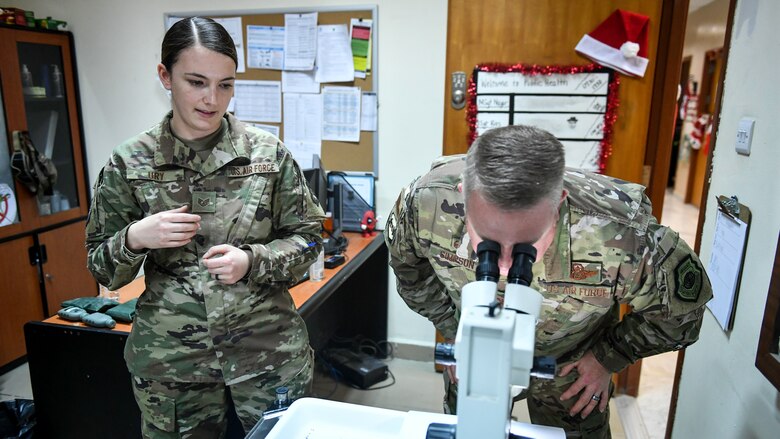Whether on the job, at home station or during deployments, the medical entomology mission fulfills a large role in keeping Airmen safe.
Operating with Public Health, medical entomologists study various insects, pests and the diseases they carry to determine how they could impact the health of service members.
"If it's going to make our troops sick, it's of medical significance to our entomologists," said Maj. Stephanie White, U.S. Air Forces in Europe - Air Forces Africa command entomologist, Air Force Installation and Mission Support Center Detachment 4, Ramstein Air Base, Germany. "We consider if vectors or pests, such as ticks, mosquitoes or rodents are present in the environment. We examine if those vectors or pests carry known pathogens, and if they can negatively affect our personnel. We then advise on mitigation recommendations to minimize the exposure."
Part of their mission includes active surveillance for the presence of vectors and pests that could potentially harm Airmen in the operational environment.
"Surveillance allows us to identify insects or pests in our environment and the potential pathogens they carry," White said. "We also assess when and why the insect or pest is present. This allows us to identify if they are a threat, and determine an acceptable level of that insect or pest in proximity to our personnel."
Medical entomologists use this information and work collaboratively with pest management personnel who will begin or modify mitigation steps to control insect or pest populations. This information may also guide recommendations to the base population to implement other personal protective measures including the use of insect repellants and mosquito nets, based on the insect or pests behaviors.
As White explains, even if an insect or pest does not carry a disease, they could still pose a significant health problem.
"When I was in Charleston (South Carolina), the Navy had training assets along the salt marshes where the mosquitoes are aggressive biters and can occur in very large numbers," White explains. "Large swarms of these mosquitoes have been responsible for the exsanguination and death of cattle along the Gulf Coast. So, when these mosquitos started attacking and causing problems for the dock workers who then couldn't do their job, this impacted the Navy's ability to complete their training.
"We needed to conduct appropriate pest mitigation that would allow the dock workers to return to work and the Navy program to continue. For this case, we implemented control through aerial spraying, provided by our reserve Airmen from the 757th Airlift Squadron in Youngstown, Ohio."
Another part of the medical entomology mission is educating Airmen on potential threats in their workplace and how to keep themselves safe. This is especially important when preparing Airmen for deployment where they may encounter insects or pests they are less familiar with and which require different safety precautions.
"Often, the threats we see at home are different when we deploy," White said. "For example, many of us learned the rhyme about patterns to identify venomous coral snakes that goes, 'Red and yellow, kill a fellow. Red and black, safe for Jack.' But that only keeps you safe in the U.S. Applying this rhyme in South America can actually get you in quite a bit of trouble. We work to get Airmen to understand that what they know at home is not necessarily effective when overseas."
Medical entomologists also bring their expertise to global health engagements and assist foreign military partners with vector disease outbreaks. They also support humanitarian responses, especially after a natural disaster where insect control measures are required so responders can continue to do their job.
According to Lt. Col. Timothy Davis, Medical Entomology Consultant to the Air Force Surgeon General, between courses, training and experience, medical entomologists are skilled in understanding how insects and pests can impact the overall mission.
"Medical entomologists have to be vector-identification specialists," Davis said. "We have to also be vector-borne disease ecologists in order to understand the complex life-cycles of the pathogens that can pass through different hosts, multiply in great numbers, and move to a human, resulting in disease. Knowing the many steps and stages to the disease cycle can assist in identifying the weak link in the chain of infection. Medical entomologists have to have a strong natural science background to truly understand what steps should be taken to keep our members safe."
The Air Force has 12 active duty medical entomologists and is looking for candidates to fill more positions around the world.
"Whether it's protecting Airmen from bed bugs and leishmaniasis in Southwest Asia, catching mosquitoes in the Caribbean to study Zika, working with local health departments in the U.S. and overseas to combat diseases, or leading a base's public health mission, the Air Force has many diverse and rewarding opportunities for medical entomologists," said Col. James Poel, Chief, Public Health Branch, Air Force Medical Readiness Agency.
To be a medical entomologist, Airmen must have at least a master's degree in entomology or in another scientific field with an entomology specialty.
To learn how you can become an Air Force medical entomologist, Air Force Specialty Code 43H3E, visit: https://www.airforce.com/careers/detail/medical-entomologist.

Staff Sgt. Shannon Ury, 386th Air Expeditionary Wing public health technician, looks on as Col. Rod Simpson, 386th Air Expeditionary Wing commander, sorts between male and female mosquito specimens during a visit to the medical group at Ali Salem Air Base, Kuwait, Dec. 12, 2019. The female mosquitoes are separated and sent to a location within the United States for entomologists to examine for viruses or diseases. (U.S. Air Force photo by Staff Sgt. Mozer O. Da Cunha)






